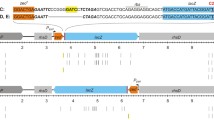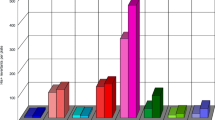Summary
Weak to severe deficit of GATC sequences in the DNA of enterobacteriophages appears to be correlated with their undermethylation during growth indam + (GATC ade-methylase) bacteria. This observation is corroborated by the sequence analysis showing no evidence for site-specific mutagenicity of 6meAde. The MutH protein of the methyl-directed mismatch repair system recognizes and cleaves the undermethylated GATC sequences in the course of mismatch repair. To enquire whether the MutH function of the methyldirected mismatch repair system participates in counterselection of GATC sequences in enterobacteriophages, we have studied the yield of bacteriophage ϕX174 containing either 0, 1, or 2 GATC sequences, in wild type,dam, andmut (H, L, S, U) Escherichia coli. Following transfection with unmethylated DNA containing two GATC sequences, a net decrease in the yield of infective particles was observed in all bacterialmutH + dam− strains, whereas no detectable decrease was observed in bacteria infected by DNA without GATC sequence. This effect of the MutH function is maximum in wild type andmutL andmutS bacteria whereas the effect is not significant inmutU bacteria, suggesting an interaction of the, helicase II with the MutH protein.
However, indam + bacteria, the presence of GATC sequences leads to an increased yield of infective particles. The effect of GATC sequence and its Dam methylation system on phage yield inmutH − bacteria reveals that methylated GATC sequences are advantageous to the phage. These results suggest that the methyl-directed mismatch repair system, and in particular its MutH protein, may have participated in severe counterselection of GATC sequences from enterobacteriophages, presumably, by DNA cleavage or by interfering with DNA replication or packaging when GATC sequences are undermethylated. Coevolution of the Dam and MutH proteins could then account for the loss of GATC sequences from DNA of bacteriophages growing indam + hosts.
Similar content being viewed by others
References
Auer B, Schweiger M (1984) Evidence thatEscherichia coli virus T1 induces a DNA methyltransferase. J. Virol 49:588–590
Bandyopadhyay PK, Studier FW, Hamilton DL, Yuan R (1985) Inhibition of the type I restriction-modification enzymesECOB andEcoiK by the gene 0.3 protein of bacteriophage T7. J. Mol Biol 182:567–578
Barbeyron T, Kean K, Forterre P (1984) DNA adenine methylation of GATC sequences appeared recently in theEscherichia coli lineage. J. Bacteriol 160:586–590
Benzinger R (1978) Transfection of Enterobacteriaceae and its applications. Microbiol Rev 42:194–236
Bird A (1986) CpG-rich islands and the function of DNA methylation. Nature 321:209–213
Caillet-Fauquet P, Maenhaut-Michel G, Radman M (1984) SOS mutator effect inE. coli mutants deficient in mismatch correction. EMBO J 3:707–712
Claverys JP, Lacks SA (1986) Heteroduplex deoxyribonucleic acid base mismatch repair in bacteria. Microbiol Rev 50:133–165
Cooper DN (1983) Eukaryotic DNA methylation. Hum Genet 64:315–333
Cooper DN, Gerber-Huber S (1985) DNA methylation and CpG suppression. Cell Diff 17:199–205
Cooper DN, Krawczak M (1989) Cytosine methylation and the fate of CpG dinucleotides in vertebrate genomes. Hum Genet 83:181–188
Cunningham RP, Dasgupta C, Shibata T, Radding CM (1980) Homologous pairing in genetic recombination: recA protein makes joint molecules of gapped circular DNA and closed circular DNA. Cell 20:223–235
Doerfler W (1983) DNA methylation and gene activity. Annu Rev Biochem 52:93–124
Dreiseikelmann B, Eichenlaub R, Wackernagel W (1979) The effect of differential methylation byEscherichia coli of plasmid DNA and phage T7 and λ DNA on the cleavage by restriction endonucleaseMboI fromMoraxella bovis. Biochim Biophys Acta 562:418–428
Geier GE, Modrich P (1979) Recognition sequence of thedam methylase ofEscherichia coli K12 and mode of cleavage ofDpnI endonuclease. J Biol Chem 254:1408–1413
Glickman BW, Radman M (1980)Escherichia coli mutator mutants deficient in methylation-instructed DNA mismatch correction. Proc Natl Acad Sci USA 77:1063–1067
Hughes JA, Brown LR, Ferro AJ (1987) Expression of the cloned coliphage T3 S-adenosylmethionine hydrolase gene inhibits DNA methylation and polyamine biosynthesis inEscherichia coli. J Bacteriol 169:3625–3632
Kornberg A (1980) DNA replication. WH Freeman, San Francisco
Krüger DH, Shroeder C, Reuter M, Bogdarina IG, Buryanov YI, Bickle TA (1985) DNA methylation of bacterial viruses T3 and T7 by different DNA methylases inEscherichia coli K12 cells. Eur J Biochem 150:323–330
Lacks SA (1988) Discussion summary: mismatch repair of DNA. In: Friedberg EC, Hanawalt PC (eds) Mechanisms and consequences of DNA damage processing. Liss, New York, pp 391–395
Lahue RS, Su SS, Modrich P (1987) Requirement for d(GATC) sequences inEscherichia coli mutHLS mismatch correction. Proc Natl Acad Sci USA 84:1482–1486
Längle-Rouault F, Maenhaut-Michel G, Radman M (1987) GATC sequences, DNA nicks, and the mutH function inEscherichia coli mismatch repair. EMBO J 6:1121–1127
Längle-Rouault F, Maenhaut-Michel G, Radman M (1986) GATC sequence and mismatch repair inEscherichia coli. EMBO J 5:2009–2013
Lindqvist BH, Sinsheimer RL (1967) Process of infection with bacteriophage ϕX174. XIV. Studies on macromolecular synthesis during infection with a lysis-deficient mutant. J Mol Biol 28:87–94
Lu AL (1987) Influence of GATC sequences onEscherichia coli DNA mismatch repairin vitro. J. Bacteriol 169:1254–1259
Lu AL, Clark S, Modrich P (1983) Methyl-directed repair of DNA base-pair mismatchesin vitro. Proc Natl Acad Sci USA 80:4639–4643
Lyons SM, Schendel PF, (1984) Kinetics of, methylation inEscherichia coli K-12. J Bacteriol 159:421–423
Manarelli BM, Balganesh TS, Greenberg B, Springhorn SS, Lacks SA (1985) Nucleotide sequence of theDpn II DNA methylase gene ofStreptococcus pneumoniae and its relationship to thedam gene ofEscherichia coli. Proc Natl Acad Sci USA 82:4468–4472
Marinus MG (1973) Location of DNA methylation genes on theEscherichia coli K-12 genetic map. Mol Gen Genet 127: 47–55
Marinus MG (1976) Adenine methylation of ogazaki fragments inEscherichia coli. J Bacteriol 128:853–854
Marinus MG, Carraway M, Frey AZ, Brown L, Arraj JA (1983) Insertion mutations in thedam gene ofEscherichia coli K-12. Mol Gen Genet 192:288–289
McClelland M (1985) Selection againstdam methylation sites in the genomes of DNA of enterobacteriophages. J Mol Evol 21:317–322
Modrich P (1989) Methyl-directed DNA mismatch correction. J Biol Chem 264:6597–6600
Muller UR, Wells RD (1980) Intercistronic regions in ϕX174 DNA. II Biochemical and biological analysis of mutants with altered intercistronic regions between genes. J and F. J Mol Biol 141:25–41
Ogden GB, Pratt MJ, Schaechter M (1988) The replicative, origin of theE. coli chromosome binds to cell membranes only when hemimethylated. Cell 54:127–135
Phillips GJ, Arnold J, Ivarie R (1987a) Mono- through hexanucleotide composition of theEschericha coli genome: a Markov chain analysis. Nucleic Acids Res 15:2611–2626
Phillips GJ, Arnold J, Ivarie R (1987b) The effect of codon usage on the, oligonucleotide composition of theE. coli genome and identification of over- and underrepresented sequences by Markov chain analysis. Nucleic Acids Res 15: 2627–2638
Radman M (1976) An endonuclease fromEscherichia coli that introduces single polynucleotide chain scissions in ultravioletirradiated DNA. J Biol Chem 251:1438–1445
Radman M, Wagner R (1986) Mismatch repair inEscherichia coli. Annu Rev Genet 20:523–538
Razin A, Cedar H (1984) DNA methylation in eukaryotic cells. Int Rev Cytol 92:159–185
Razin A, Szyf M (1984) DNA methylation patterns: formation and function. Biochim Biophys Acta 782:331–342
Sanger F, Air GM, Barrell BG, Brown NL, Coulson AR, Fiddes JC, Hutchison CA III, Slocombe PM, Smith M (1977) Nucleotide sequence of bacteriophage ϕX174 DNA. Nature 265: 687–695
Sharp PM (1986) Molecular evolution of bacteriophages: evidence of selection against the recognition sites of host restriction enzymes. Mol Biol Evol 3:75–83
Schekman RW, Iwaya M, Bromstrup K, Denhardt DT (1971) The mechanism of replication of ϕX174 single-strand DNA. III. An enzymic study of the structure of the replicative form II DNA. J Mol Biol 57:177–199
Spoerel N, Herrlich P (1979) Colivirus-T3-coded S-adenosylmethionine hydrolase. Eur J Biochem 95:227–233
Spoerel N, Herrlich P, Bickle TA (1979) A novel bacteriophage defense mechanism: the anti-restriction protein. Nature 278: 30–34
Szyf M, Avraham-Haetzni K, Reifman A, Shlomai J, Kaplan F, Oppenheim A, Razin A (1984) DNA methylation pattern is determined by the intracellular level of the methylase. Proc Natl Acad Sci USA 81:3278–3282
Szyf M, Meisels E, Razin A (1986) Biological role of DNA methylation: sequence-specific single-strand breaks associated with hypomethylation of GATC sites inEscherichia coli DNA. J Bacteriol 168:1487–1490
Vaccaro KK, Siegel EC (1977) The frameshift mutability ofPolA1 andrecA1 derivatives of mutator strains ofEscherichia coli. Mutat Res 42:443–446
Wagner EF, Auer B, Schweiger M (1979) Development ofEscherichia coli virus T1: escape from host restriction. J Virol 29: 1229–1231
Welsh KM, Lu AL, Clark S, Modrich P (1987) Isolation and characterization of theEscherichia coli mutH gene product. J Biol Chem 262:15624–15629
Yomo T, Ohno S (1989) Concordant evolution of coding and noncoding regions of DNA made possible by the universal rule TA/CG deficiency-TG/CT excess. Proc Natl Acad Sci USA 86:8452–8456
Author information
Authors and Affiliations
Rights and permissions
About this article
Cite this article
Deschavanne, P., Radman, M. Counterselection of GATC sequences in enterobacteriophages by the components of the methyl-directed mismatch repair system. J Mol Evol 33, 125–132 (1991). https://doi.org/10.1007/BF02193626
Received:
Revised:
Issue Date:
DOI: https://doi.org/10.1007/BF02193626




